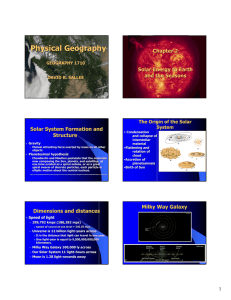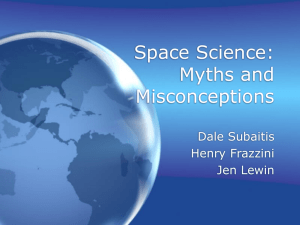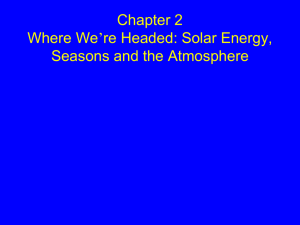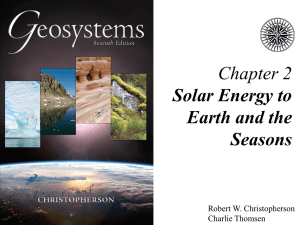ch02_Lecture
advertisement
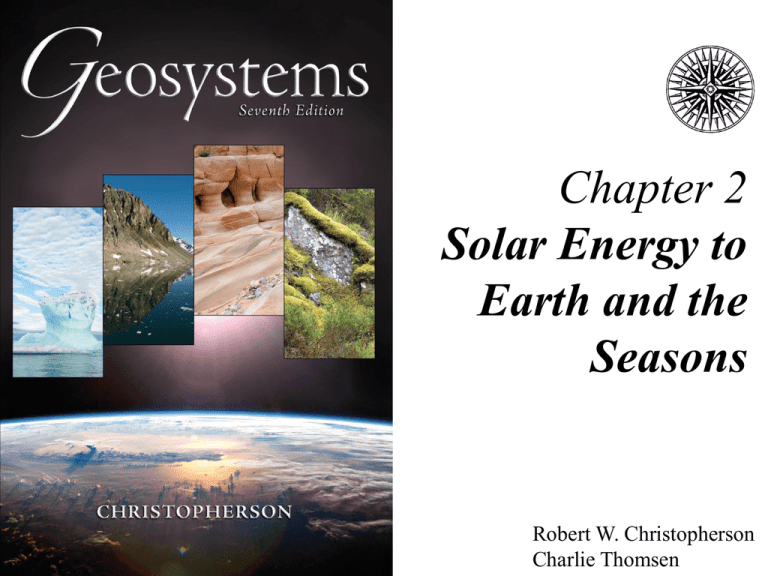
Chapter 2 Solar Energy to Earth and the Seasons Robert W. Christopherson Charlie Thomsen Solar Energy to Earth and the Seasons The Solar System, Sun, and Earth Solar Energy: From Sun to Earth The Seasons The Solar System, Sun, and Earth Solar System formation and structure Gravity Planetesimal hypothesis Dimensions and distances Speed of light Earth’s orbit Solar System Formation and Structure Gravity Mutual attracting force exerted by mass on all other objects Planetesimal hypothesis Suns condense from nebular clouds Dimensions and Distances Speed of light 299,792 kmps (186,282 mps) Milky Way Galaxy 100,000 ly across Our Solar System 11 light-hours across Moon is 1.28 light-seconds away Milky Way Galaxy Figure 2.1 Dimensions and Distances Earth’s orbit Average distance from Earth to the Sun is 150,000,000 km (93,000,000 mi) Perihelion – closest at January 3 147,255,000 km (91,500,000 mi) Aphelion – farthest at July 4 152,083,000 km (94,500,000 mi) Earth is 8 minutes 20 seconds from the Sun Plane of Earth’s orbit is the plane of the ecliptic Our Solar System Figure 2.1 Solar Energy: From Sun to Earth Solar activity and solar wind Electromagnetic spectrum of radiant energy Intercepted energy at the top of the atmosphere Solar Activity and Solar Wind Solar wind is clouds of electrically charged particles Sunspots are caused by magnetic storms Sunspots have activity cycle of 11 years Figure 2.2 Aurora Borealis Figure 2.4 The Electromagnetic Spectrum Sun radiates shortwave energy Shorter wavelengths have higher energy Earth radiates longwave energy Wavelength and Frequency Figure 2.5 The Electromagnetic Spectrum Figure 2.6 Solar and Terrestrial Energy Figure 2.7 Earth’s Energy Budget Figure 2.8 Distribution of Insolation Tropics receive more concentrated insolation due to Earth’s curvature Tropics receive 2.5× more than poles Figure 2.9 The Seasons Seasonality Reasons for seasons Annual march of the seasons Insolation at Top of Atmosphere Figure 2.10 Seasonality Seasonal changes Sun’s altitude – angle above horizon Declination – location of the subsolar point Daylength Daily Net Radiation Figure 2.11 Reasons for Seasons Revolution Rotation Tilt of Earth’s axis Axial parallelism Sphericity Reasons for Seasons Revolution Earth revolves around the Sun Voyage takes one year Earth’s speed is 107,280 kmph (66,660 mph) Rotation Earth rotates on its axis once every 24 hours Rotational velocity at equator is 1674 kmph (1041 mph) Revolution and Rotation Figure 2.13 Reasons for Seasons Tilt of Earth’s axis Axis is tilted 23.5° from plane of ecliptic Axial parallelism Axis maintains alignment during orbit around the Sun North pole points toward the North Star (Polaris) Sphericity Axial Tilt and Parallelism Figure 2.14 Annual March of the Seasons Winter solstice – December 21 or 22 Subsolar point Tropic of Capricorn Spring equinox – March 20 or 21 Subsolar point Equator Summer solstice – June 20 or 21 Subsolar point Tropic of Cancer Fall equinox – September 22 or 23 Subsolar point Equator Annual March of the Seasons Figure 2.15 11:30 P.M. in the Antarctic Figure 2.16 Midnight Sun Figure 2.17 Seasonal Observations Figure 2.18 End of Chapter 2 Geosystems 7e An Introduction to Physical Geography Robert W. Christopherson Charlie Thomsen

